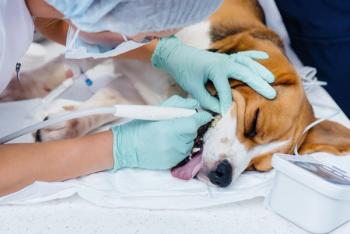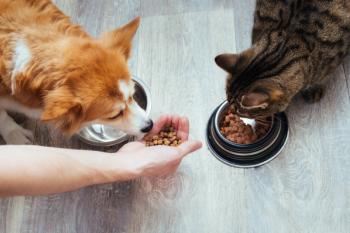
Navigating unusual euthanasia requests
All good things must come to an end, and pets are nothing but good in their owners' eyes. Here's some advice from Dr. Mary Gardner on how to best handle those last moments, even when an unexpected entreaty arises.
Bon voyage, my friend. (Shutterstock)
It's a harsh truth that part of having a pet is losing a pet-the circle of life in which our own circles' diameters quite outsize those of our cats, dogs and other furry, scaly or feathered friends. But when the owner-pet relationship has been so rewarding, making sure the end is just as rewarding can be key to helping the pet pass away peacefully and the owner be able to look back with only happy memories, even in the last moments.
At her presentation on unique requests postmortem at the NAVC earlier this year, Mary Gardner, DVM, inspired the audience toward laughter and tears at the ways some owners chose to say goodbye to their pets-all in the celebration of people's love for their nonhuman family members.
Dr. Gardner with a client right after a euthanasia. (All photos courtesy of Dr. Mary Gardner)Dr. Gardner is one of the founding members of Lap of Love Veterinary Hospice, so she has seen all aspects of the end-of-life process. She has had clients request to take pictures during a euthanasia and after. One pet owner even wanted Dr. Gardner in the photo because they had had such a great relationship throughout the hospice care process. In the resulting photo (above), both Dr. Gardner and the owner are smiling because the pet had passed on under the best circumstances possible, exactly as planned.
Photos taken during a euthanasia.
Dr. Gardner's own Serissa after euthanasia.
Some of Dr. Gardner's clients have even wanted to watch the cremation of their pets.
A cat ready for cremation. The owner was present to watch the process.This raises an important issue: “You must know your crematory,” Dr. Gardner says, since they are your partner in this essential step of a pet's passing. Ask yourself:
> Is it clean?
> Is the pet handled respectfully?
> What is the office like (if an owner wants to visit)?
> What type of vehicles do they use to pick up the pet from an owner's home?
> Do they use a nice stretcher with a blanket to pick up a pet from an owner's home or do they put the pet in a cadaver bag in front of the owner?
> Are the pets separated by bricks or in their own compartment?
> And, most important, would you feel comfortable having your own pet cremated by them?
You might face unique questions as well, says Dr. Gardner. She has heard: “When will my pet get cold?” Answer: The pet will lose about 1 degree of temperature per hour. “Can I keep my dog's body for several days?” Answer: That would be OK but it will start to smell a bit.
Unusual keepsakes Dr. Gardner has had owners request:
> Paw impressions from all four paws or nose impressions. Once an owner wanted a tail impression of his cat.
> Nail clippings
> Paws (Dr. Gardner said she wouldn't do this and that it would be best to talk to a taxidermist.)
> Speaking of taxidermy, taxidermy
> Teeth
> The ashes so the owner could mix them in with ink for a tattoo
> Lots of fur (one owner shaved her malamute so she could make a sweater)
> The skin of a horse that had been branded so the owner could make leather out of the branded area
> Samples for breeding or cloning
A horse hoof impression.Dr. Gardner mentioned an option for those clients not quite wanting to take the taxidermy route-
The ultimate lesson in all of this-treat a pet owner's request with respect, says Dr. Gardner. Don't recoil or laugh. Each person handles loss differently, and some requests may help owners with their grieving process.
“Be prepared for the unique requests, and when they are asked, remain calm and compassionate,” Dr. Gardner says. “Consider their request as an opportunity to go above and beyond for your client, and possibly give them a gift that others may not be open to. Think before immediately saying, ‘No,' and minimally say, ‘I've not done that yet, let me see if that is possible.'
As Dr. Gardner puts it, 30 years ago a claw paw impression may have been scoffed at, yet now it is the norm. In five years, maybe it will be nose impressions. So maybe a bit of brushing up on your arts and crafts would be helpful.
Newsletter
From exam room tips to practice management insights, get trusted veterinary news delivered straight to your inbox—subscribe to dvm360.




